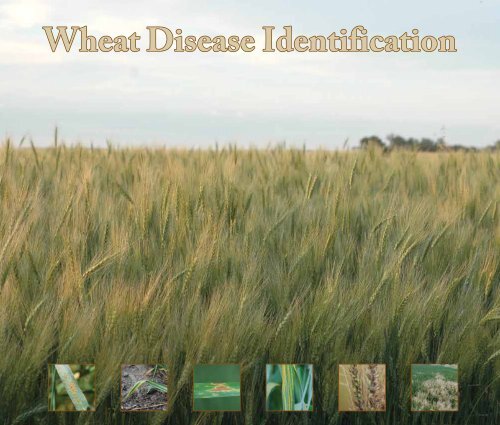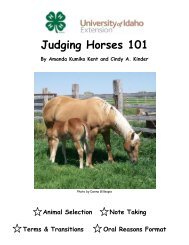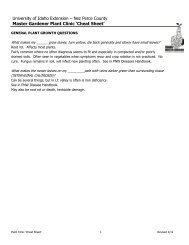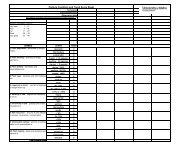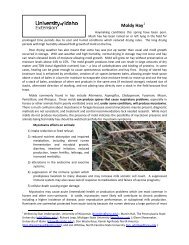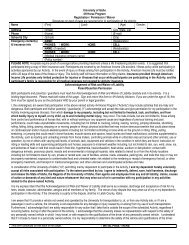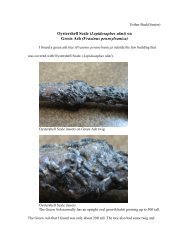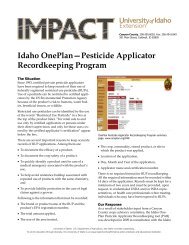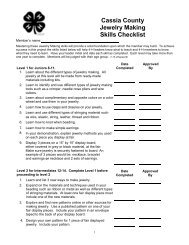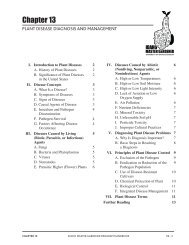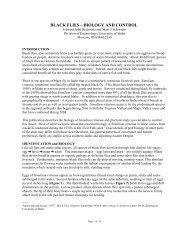Wheat Disease Identification Guide - University of Idaho Extension ...
Wheat Disease Identification Guide - University of Idaho Extension ...
Wheat Disease Identification Guide - University of Idaho Extension ...
- No tags were found...
Create successful ePaper yourself
Turn your PDF publications into a flip-book with our unique Google optimized e-Paper software.
Contents<strong>Disease</strong>s affecting heads and grainCommon bunt.......................................................................... 1Fusarium head blight................................................................ 2Loose smut............................................................................... 3Sooty head molds...................................................................... 4Stagonospora nodorum blotch.................................................. 5<strong>Disease</strong>s affecting leavesBacterial streak......................................................................... 6Barley yellow dwarf................................................................... 7Leaf rust................................................................................... 8Powdery mildew....................................................................... 9Septoria tritici blotch...............................................................10Stagonospora nodorum blotch.................................................11Stem rust................................................................................ 12Stripe rust.............................................................................. 13Tan spot..................................................................................14<strong>Wheat</strong> soilborne mosaic.......................................................... 15<strong>Wheat</strong> spindle streak mosaic....................................................16<strong>Wheat</strong> streak mosaic...............................................................17<strong>Disease</strong>s affecting stem and rootsCephalosporium stripe............................................................18Common root rot.....................................................................19Fusarium root, crown, and foot rots........................................ 20Take-all................................................................................. 21
Loose smutThe normal head tissue <strong>of</strong> plants infected by loose smutis completely replaced with dark masses <strong>of</strong> fungal spores,giving the heads a black powdery appearance. It ispossible to see heads damaged by loose smut while much<strong>of</strong> the head is still inside the boot. Only the central stem<strong>of</strong> the head is left after the spores are released.Management: Fungicide seed treatment, disease-freeseed sources.<strong>Disease</strong>s affecting heads and grain3
<strong>Disease</strong> affecting leavesBacterial streakEarly symptoms <strong>of</strong> bacterial streak include small, watersoakedareas between leaf veins. These water-soakedareas become tan streaks within a few days. Whenthe disease is severe, streaks may merge to form large,irregular areas <strong>of</strong> dead tissue. When dew is present, thebacteria causing this disease may ooze from the lesionsand dry to form a clear, thin film. This film flakes easilyand is visible when the leaf is viewed from differentperspectives.Management: Avoid highly susceptible varieties.6
<strong>Disease</strong> affecting leavesLeaf rustSmall, orangish-brown lesions are key features <strong>of</strong> leafrust infections. These blister-like lesions are mostcommon on leaves but can occur on the leaf sheath,which extends from the base <strong>of</strong> the leaf blade to the stemnode. Lesions caused by leaf rust are normally smaller,more round, and cause less tearing <strong>of</strong> the leaf tissue thanthose caused by stem rust.Management: Genetic resistance, foliar fungicides.8
Powdery mildewPowdery mildew causes white lesions on leaves and leafsheaths. Glumes and awns also can be infected whendisease is severe. Fungal growth is largely limited toouter plant surfaces and can be easily wiped away byrubbing a finger across affected areas. Mature lesionsmay have dark, reproductive structures mixed with thewhite, cottony growth <strong>of</strong> the fungus.Management: Genetic resistance, foliar fungicides.<strong>Disease</strong> affecting leaves9
<strong>Disease</strong> affecting leavesSeptoria tritici blotchThis fungal disease causes tan, elongated lesions onwheat leaves. Lesions may have a yellow margin, butthe degree <strong>of</strong> yellowing varies among varieties. Thedark, reproductive structures produced by the fungus arekey diagnostic features and can <strong>of</strong>ten be seen withoutmagnification. This disease is also known as speckledleaf blotch.Management: Genetic resistance, foliar fungicides, croprotation.10
Stagonospora nodorum blotchThe lesions <strong>of</strong> Stagonospora leaf blotch are normallybrown or tan, surrounded by a thin, yellow halo. Lesionscaused by Stagonospora leaf blotch are more irregularin shape and <strong>of</strong>ten have a darker color than those <strong>of</strong>tan spot. The presence <strong>of</strong> small, honey-colored fungalreproductive structures is diagnostic for Stagonosporanodorum blotch; however, these reproductive structuresare only visible with considerable magnification.Management: Genetic resistance, foliar fungicides, croprotation, fungicide seed treatment.<strong>Disease</strong> affecting leaves11
<strong>Disease</strong> affecting leavesStem rustStem rust causes blister-like lesions on leaves, leafsheaths, and stems. Infection <strong>of</strong> glumes and awns is alsopossible. The reddish-brown spores <strong>of</strong> the fungus causeconsiderable tearing as they burst through the outerlayers <strong>of</strong> the plant tissues. Mature stem rust lesions aremore elongated than those <strong>of</strong> leaf rust.Management: Genetic resistance, foliar fungicides.12
Stripe rustStripe rust causes yellow, blister-like lesions that arearranged in stripes. The disease is most common onleaves, but head tissue also can develop symptoms whendisease is severe. Outside the United States, this diseaseis sometimes referred to as yellow rust.Management: Genetic resistance, foliar fungicides.<strong>Disease</strong> affecting leaves13
<strong>Disease</strong> affecting leavesTan spotThe key diagnostic feature <strong>of</strong> tan spot is tan lesionswith a yellow margin. Mature tan spot lesions <strong>of</strong>tenhave a dark area in the center. Lesions may merge asthey expand, resulting in large sections <strong>of</strong> diseased leaftissue. The fungus that causes tan spot survives in thedebris <strong>of</strong> previous wheat crops and produces small, blackreproductive structures in the spring.Management: Avoid planting into wheat residue, tillagewhere appropriate, genetic resistance, foliar fungicides.14
<strong>Wheat</strong> soilborne mosaicWinter wheat infected by wheat soilborne mosaicdevelops a pale-yellow discoloration shortly after breakingdormancy in the spring. The incidence <strong>of</strong> wheat soilbornemosaic is <strong>of</strong>ten greater in low areas <strong>of</strong> a field, wheremoist soil conditions favor growth <strong>of</strong> the protozoa thatspread this viral disease. Leaves <strong>of</strong> infected plants <strong>of</strong>tenhave a mosaic pattern <strong>of</strong> dark green blotches on a paleyellowbackground. Symptoms normally fade when warmweather slows the viral activity within infected plants.Management: Genetic resistance.<strong>Disease</strong> affecting leaves15
<strong>Disease</strong> affecting leaves<strong>Wheat</strong> spindle streak mosaic<strong>Wheat</strong> spindle streak mosaic causes a yellowdiscoloration to wheat seedlings. This yellowdiscoloration is <strong>of</strong>ten most intense in the wettest areas<strong>of</strong> a field. Leaves <strong>of</strong> infected plants have long, yellowstreaks that are slightly wider in the middle than at theirends. Symptoms are similar to wheat soilborne mosaic,and plants <strong>of</strong>ten are infected with both diseases.Management: Genetic resistance.16
<strong>Wheat</strong> streak mosaicLeaves <strong>of</strong> plants infected with wheat streak mosaic havea bright yellow streaking. Symptoms are <strong>of</strong>ten mostsevere near the leaf tip. The virus that causes wheatstreak mosaic survives in volunteer wheat and is spreadby wheat curl mites. The disease is <strong>of</strong>ten most severein areas <strong>of</strong> a field that are closest to these sources <strong>of</strong>the disease and mites. Commonly, plants infected withwheat streak mosaic also are infected with High Plainsdisease and Triticum mosaic. The symptoms <strong>of</strong> thesediseases are nearly identical. <strong>Disease</strong> severity is greaterwhen plants are infected by more than one virus.Management: Control volunteer wheat, delayedplanting date, genetic resistance, avoid planting nearmaturing corn.<strong>Disease</strong> affecting leaves17
<strong>Disease</strong>s affecting lower stem and rootsCephalosporium stripePlants infected with Cephalosporium stripe havepronounced yellow stripes running the full length <strong>of</strong>the leaf blade. The center <strong>of</strong> the yellow stripe may havea long, brown streak that extends onto the leaf sheath.Splitting the stem <strong>of</strong> infected plants <strong>of</strong>ten reveals small,brown streaks within the node tissue. Cephalosporiumstripe also can cause areas <strong>of</strong> stunted, irregular growthwithin a field. Often, infected plants die prematurely,causing patches <strong>of</strong> white heads within a field.Management: Genetic resistance, crop rotation, controlgrassy weeds.18
Common root rotCommon root rot causes premature death <strong>of</strong> wheat,resulting in patches <strong>of</strong> white heads scattered throughouta field. Infected plants are <strong>of</strong>ten dark at the base andhave poor root development. A key diagnostic feature<strong>of</strong> common root rot, however, is dark-brown lesions onthe thin stem extending from the base <strong>of</strong> the plant tothe remnant <strong>of</strong> the seed. This thin stem is known asthe “subcrown internode.” Healthy subcrown internodesshould be cream colored and firm.Management: Crop rotation, control grassy weeds.<strong>Disease</strong>s affecting lower stem and roots19
<strong>Disease</strong>s affecting lower stem and roots<strong>Disease</strong>s affecting lower stem and rootsFusarium root, crown, and foot rotsFusarium root, crown, and foot rots cause patches <strong>of</strong>wheat to die prematurely, resulting in areas <strong>of</strong> whiteheads within a field. Infected plants are typically brownat the base and have poor root development. Duringadvanced stages <strong>of</strong> the disease, the Fusarium fungus<strong>of</strong>ten produces a pink, cottony growth inside the lowerportions <strong>of</strong> the stem. Often, the disease is most severeafter prolonged periods <strong>of</strong> dry weather.Management: Crop rotation, control grassy weeds.20
Take-allThis fungal disease causes wheat to die prematurely,resulting in patches <strong>of</strong> white heads in otherwise greenfields <strong>of</strong> wheat. Plants infected by take-all normallyhave a black discoloration <strong>of</strong> the lower stem and roots.Frequently, the disease is most severe in wet areas <strong>of</strong> afield and near field edges where the fungus survives inassociation with grassy weeds.Management: Crop rotation, control grassy weeds.<strong>Disease</strong>s affecting lower stem and roots21
AcknowledgementsThis publication was developed by the multi-stateextension and research committees for small graindiseases, NCERA-184 and WERA-97. Publicationauthors: Erick De Wolf, James P. Shroyer, and BrianOlson, Kansas State <strong>University</strong>. Photo credits: ErickDe Wolf, Bill Bockus, James P. Shroyer, and Bill Willis,Kansas State <strong>University</strong>; Tim Murray, WashingtonState <strong>University</strong>; and Marcia McMullen, NorthDakota State <strong>University</strong>. The USDA-NIFA <strong>Extension</strong>Integrated Pest Management program award 2009-41533-05331 sponsored development and distribution <strong>of</strong>this publication.For additional assistance identifying diseases<strong>of</strong> wheat contact:Juliet MarshallCereals Cropping Systems,Agronomy and PathologyAssistant Pr<strong>of</strong>essor<strong>University</strong> <strong>of</strong> <strong>Idaho</strong>, <strong>Idaho</strong> Falls1776 Science Center Drive Suite 205<strong>Idaho</strong> Falls, ID 83402-1575(208) 529-8376This publication was developed and distributed with the assistance <strong>of</strong> the U.S. Department <strong>of</strong>Agriculture (USDA). The USDA prohibits discrimination in all its programs and activities on thebasis <strong>of</strong> race, color, national origin, age, disability, and where applicable, sex, marital status,familial status, parental status, religion, sexual orientation, genetic information, politicalbeliefs, reprisal, or because all or part <strong>of</strong> an individual’s income is derived from any publicassistance program.March 2011


